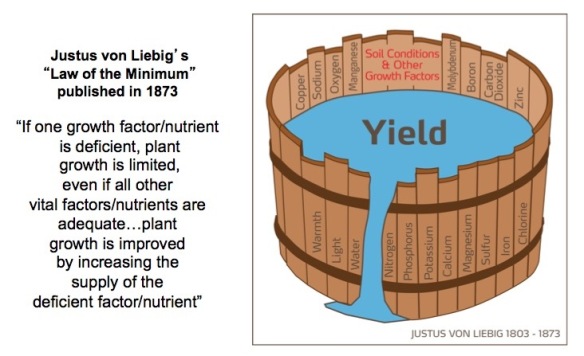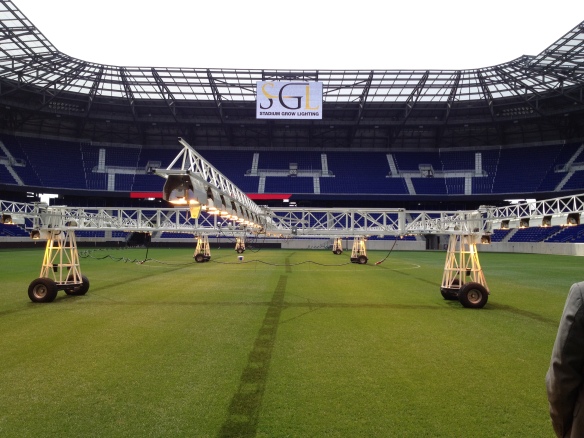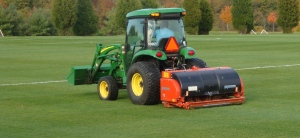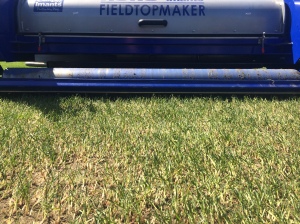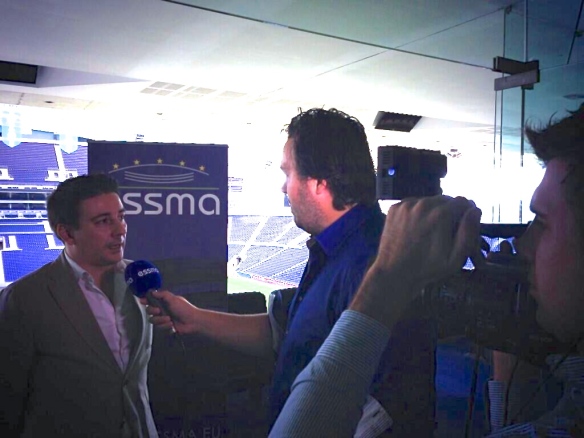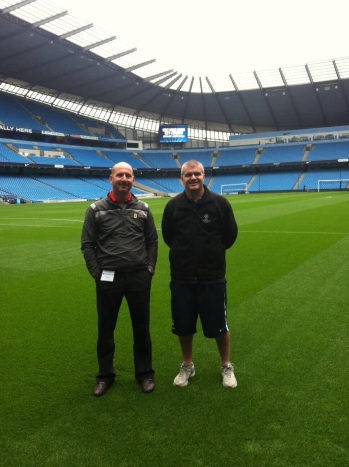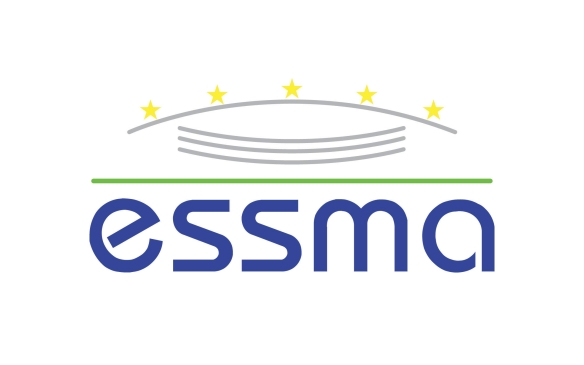
Jerad R. Minnick
ESSMA Head Grounds Managers Seminar
Estadio do Dragao, Home of FC Porto
SEE PRESENTATION HERE:
ESSMA Keynote Presentation
#Think.Different
(Slide 1) Welcome to the 2013 ESSMA Head Grounds Managers Seminar! Thank you to Ricardo Carvalho, Stadium Manager FC Porto, and all of FC Porto for hosting us. Let’s all give FC Porto a hand to say Thank You again! (Applause)
(Slide 2) And Thank You to Dimitri (Huygen.. Managing Director of ESSMA) for the introduction. I am Jerad Minnick from the Maryland SoccerPlex in the USA
(Slide 3) Maryland SoccerPlex is a 22 field, 160 acre park on the northwest of the Washington, DC metropolitan area. (Slide 4) DC, the capital city of the USA, it approximately 4 hours south of New York City by car. (Gov shut down joke… its Day 2 of the shutdown)
(Slide 5) Amazingly, to illustrate how large the USA is, the place I grew up and started my career is 16 hours to the west of Washington, DC by car. That would be the equivalent of driving from here (Porto) to somewhere like Frankfurt, Germany. Yet that is barely only HALF WAY across the USA. Absolutely we are a big country, with a wide range of challenges when it comes to grass fields and stadiums.
(Slide 6) Speaking of American stadiums, the place 16 hours to the west of DC is where my management career started… at Kauffman Stadium in Kansas City w/ Head Grounds Manager Trevor Vance. (Slide 7) I then had the privilege to work with Sporting Kansas City of Major League Soccer in establishing their training ground and working towards building their magnificent new stadium. The challenges and lessons of those experiences prepared me for current roll at the Maryland SoccerPlex (Slide 8).
More about SoccerPlex… Our facility boasts 22 full size fields. (Slide 9) Of those fields, 10 are Kentucky bluegrass. (Slide 10) 5 Kentucky bluegrass fields are on a native clay soil w/ topdrain, 4 are native clay soil w/ no drainage, and 1.. SoccerPlex Stadium.. is a full sand based field w/ the American version of fibresand.
(Slide 11) 9 more of the SoccerPlex fields are bermudagrass. (Slide 12) 7 of those bermudagrass fields are on native clay soil and the 2 other fields are newly constructed on pure sand.
Why the 2 kinds of fields? DC is in the middle of the “transition zone” where both grasses grow actively for about 6 months. Temperatures range from -18 C (0 F) in the winter to 40 C (105 F) in the summer. So in the DC region, we are able to use each grass as a “tool” for extra events. In the heat of the summer, bermudagrass is nearly indestructible and can be played on and played on and played on. Then in the spring and fall, we can equally load up the Kentucky bluegrass w/ extra events such as trainings and clinics in addition to the regular scheduled matches. All fields are always open, but the stronger grass in its prime season allows for extra use above and beyond.
So as we talk about events (Slide 13), currently our facility hosts somewhere around 8,000 events per year. That is an average of 350 matches/ trainings/ events per field equating into about 700 hours. With the amount of traffic, we all (management staff AND grounds staff) feel that we are still only at about 75% of our available capacity. Our grounds staff goal is to reach a total of 500 matches/ trainings/ events per field per year by 2015. That equals 11,000 total events.
OK… obviously this is an AGGRESSIVE goal!!! I can see the look on your faces! haha
(Slide 14) And via industry accepted thinking and historical data…. THAT IS IMPOSSIBLE!!
(Slide 15) RIGHT?!?!
(Slide 16) Just like it was IMPOSSIBLE to sail around the world because the WORLD WAS FLAT!!
This IMPOSSIBLE word reminds me of a story that is told in the USA about a college student who showed up late for his math final exam. The student rushes in, grabs his test, then sits down and diligently goes to work. Only being a few minutes late, the student is alarmed as other students were wrapping up and turning in the test with several minutes left in the class period… yet he was having a bit of a struggle with the last 2 problems on the test. But the student didnt give in. He worked and worked until the time ran out, though he was the only person left in the class. The next day, the professor phoned the student and proclaimed “Congratulations!! You are a genius!!! You answered the last 2 questions!!”. Confused, the student asked the professor what he meant. The professor explained that the last 2 questions on the test were “brain teasers” for extra credit… that they might not have had an answer. Yet the student had answered both when no one else in the class even made an attempt at answering them.
Turns out the student, in his tardiness, had missed the announcement that the last 2 problems were extra and might be “impossible”. Knowing no different… the student found a way to answer them both.
Amazing what can be accomplished when the negative thinking is kept out.
(Slide 17) “IMPOSSIBLE is not something that can not be done. It is actually just something that has not been done YET.”
An example from my childhood: I illustrated how I started my career 16 hours west of the Washington, DC area in Kansas City. Well until I was 18, I grew up/ raised by my parents in a farm village called Lock Springs, that is about 2 hours north of Kansas City. Back home, and all across the heartland of the USA, farms operate nearly independent of any major piece of society support. There is never “won’t” or “can’t” when it comes to a challenge, farmers are forced to find a way to make the impossible possible. Their livelihoods depend on it. Without facing challenges, the crops don’t succeed and/or they do not eat. Never in my 18 years of home life did I hear “impossible” or “can’t” from my grandfather or father’s mouths. Even today as we speak, my dad is out there on the farm “finding a way!”. Nothing is impossible when there is no other option!
(Slide 18) So for us to achieve 500 matches a year on a field at Maryland SoccerPlex (or on any field in the world), we must abandon historical inside the box thinking…. and #THINK.DIFFERENT.
So then I ask the group. When/ who decided anything in life is IMPOSSIBLE? Who decided that grass fields can’t take more? (Slide 19) Are they the same negative people in the early 1980’s told Steve Job, the co-founder of Apple, that people do not need a personal computer? That computers never will be popular/ useable? Well who today has one of these? (pull out my IPhone and show the group… and every hand goes up) SURPRISE!! (Slide 20) Personal computers are rather popular!!!
Are the people who decide grass fields can’t take more the same people who told Henry Ford that horses were an acceptable means of transportation? (Slide 21) Ford commented that when he asked people what they needed, they responded by saying “we need a faster horse”. Well that’s a fast horse!! (Slide 22). Not only did thinking leave the box of a faster horse… we advanced to airplanes (Slide 23), space shuttles (Slide 24), and even a car on the moon!!! (Slide 25). (Slide 26)… is that the original Ford car on the moon?!? haha.
WOW that advanced QUICKLY!! All because of thinking outside the box and not accepting the “normal” thought that something is IMPOSSIBLE.
(Slide 27) #THINK.DIFFERENT
(Slide 28) An example from my career: During my time serving with the management team at Sporting Kansas City, we were faced with a challenge. The existing stadium was no longer available. But before a new stadium was built, a temporary home had to be found and prepared. The facility that best matched the organization’s needs was not a soccer stadium: It was a baseball stadium! Baseball and soccer had shared the same field at RFK Stadium in Washington, DC… so it had been done before. But when done, the expense was massive in 2 parts: 1) the field suffered for baseball and for soccer, and 2) sport conversions cost was over $80,000 American dollars. Neither of these could be an option for us if the team was going to be able to win and organization make any money at all.
So the team Development Vice President, Mr. David Ficklin, and myself hopped a flight to Washington, DC to study and learn from the baseball and soccer set up at RFK. We studied each of the pieces of the baseball to soccer/ soccer to baseball conversion. It was never that we “can’t” do this. It was never considered that the feat was “impossible”. I can recall vividly how confident and committed Mr. Ficklin was to the fact that we WOULD find an answer to make the conversion cost more affordable AND to make a playing surface where neither baseball or soccer suffered.
(Slide 29) And then the “ah ha” moment came. You have those right? The “ah ha” moment where everything just makes sense? Where the dots all get connected? Well with thinking about what was POSSIBLE… instead of what was IMPOSSIBLE… it hit me. Starting my management career in baseball, I knew the ins and outs of baseball field maintenance well. The use of the baseball dirt areas is not as common as it would seem that it is. Grass repair work on a baseball field generally always takes place because the 2nd baseman and the shortstop both spend a good amount of time playing back on the grass arch of the infield. Also, the baselines do not get used as much as one thinks: Watch a baserunner slap a basehit to the outfield. He is going to round 1st base wide, not using the baseline.
(Slide 30) So the answer to our challenge was clear. Turning the dirt infield skin into grass with dirt sliding areas around each base. The concept was being used on multiple fields around the country; though each of them was synthetic. But still, with aggressive grass maintenance, I was convinced we could make it happen. The surface would be consistent and smooth. And we could cut our conversion costs down to around $10,000 American dollars for the field. Neither sport, or the budget, would suffer from playing both sports.
The negative feedback from field “experts” for both sports was endless. “Can’t”. “Impossible”. Even “ridiculous” are things I heard about the grass infield concept. Yet in 3 seasons, the field won Field of the Year awards from both baseball and soccer. The concept not only worked… it worked WELL. We had hoped that the example would set a trend for baseball fields to go to grass infields across the south US, as the grass would help baseball teams cut down their rain out potential by reducing the amount of dirt needing covered. But No. Even with the positive example, the negative thinking was not turned.
(Slide 31) Another example: Last fall at SoccerPlex, we did a stadium field renovation. An organic layer build up and poa annua infestation had reduced the field’s ability to sustain heavy use, so it was time to improve the surface. But as we considered replacing the field, I had 2 concerns. 1) The best bluegrass genetics were not available in sod yet as growers across the US had not started producing the newest and best for sod. And 2) the introduction of a sod /organic layer limited our ability to use the stability fibers in our stadium sand. Our fibers, the American version of fibresand, were not being used correctly when sod was unrolled across them instead of seed being sewed into them where the plant roots could weave completely into them and form stability.
During a trip to the UK, France, Holland, and Spain last May, the common question from Head Grounds Managers (many of whom are in this room, and I THANK!) was why sod when you I should be seeding? Seeding in the USA is not common. In fact, it NEVER happens. I spent some time with Jason at Leeds rugby last week and he told me about his field renovation last winter… the field was re-built, then sodded as it was the dead of winter and in the middle of the season. Yet when the season ended, their 1st action was to come in and cut out the sod and SEED the field to remove the sod/ sand interface. WOW. If Jason told that story in the USA, half the room (Academics and Grounds Managers alike) would get up and walk out of the room as if Jason was claiming he landed on the moon!! We. Do. Not. Seed. To. Establish. Fields.
With that said, we decided to seed SoccerPlex Stadium. The negative feedback equaled the positive feedback. “Can’t”. “Won’t”. “Impossible”. It was a common theme… even (Slide 32) people took to social media and publicly voiced their dis-belief. One day I am going to be giving a talk with this slide in it, and this guy is going to be in there. Guess I owe him a beer… but ultimately I think he owes ME a beer… Because 35 Days after seeding, the field was open (Slide 33)
(Slide 34) #Think.Different: If we keep the thinking of the negative people who publicly proclaim things are impossible, we will never advance.
(Slide 35) The ESSMA Stadium Partners set a fantastic example of #Think.Different and outside the box. It is why it is an honor for me to be here with you in Porto giving this talk. Examples:
In the middle 90’s Ko Rodenburg would not accept the fact that poa annua control and seed clean up was not possible. (Slide 36) Hence the KORO Field Topmaker was born and the KORO Renovation Revolution began!
(Slide 37) Nico van Vuuren knew that he could grow roses inside, year round. So why couldn’t grass grow inside?!? Now it can!!! (Slide 38) SGL was born.
(Slide 39) #Think.Different
(Slide 40) Sand base fields are necessary for drainage and compaction. But stability issues, especially with rye grass, are common on sand. (Slide 41) Desso decided stability can just be sewed right into the sand!
(Slide 42) Stadiums of the 21st century ARE multi use venues. They are entertainment venues. Not just sports fields. (Slide 43). Concerts happen the night before athletic competitions now. (Slide 44). But with Terraplas, that becomes possible! This photo, from FC Dallas Stadium (the premier soccer surface in the USA) shows damage from a concert the night before. Wait? What damage? (right side shows a small amount of yellow.. look CLOSE though!)
(Slide 45) #THINK.DIFFERENT!
(Slide 46) GRASS FIELDS CAN TAKE MORE!!!
ESSMA’s core values are the foundation of how grass fields can take more. Friendship is at work here in the room today. Respect is what we have for our colleagues hard work and results. Excellence describes that work. Teamwork is base for excellence to gain respect. And Integrity wraps it all together in an ethical manner. All of these values build the foundation for positive thinking and communication. Communication. Communication.
(Slide 47) Open communication (taking place right here in this room!) around the world is what leads to innovation. I use a Steve Jobs story again, fittingly as he is the modern world example and founder of #Think.Different: In 1983 in an award speech for innovation, Mr. Jobs references the importance of experience on innovation. Experiencing situations outside of our own is how creative thinking is born. Sharing ideas and experiences just as we are here in this room today with 10 different languages being spoken and a multitude of challenges being faced… Today we all sit here together as ONE. As we communicate and exchange experiences, we realize that the person next to us has answers to questions that we have. We have answers to questions that they have. And together we all have answers to questions that others may not even know that need to be asked!!!
WOW!!! Now that is POWERFUL!!!
Think about that... right now, someone in this room has the answer to a question that before the day started, they didn’t even know needed to be asked. I have shown examples: We at SoccerPlex didn’t even think about the question needing to be asked was “what seed”… not “what sod”. Henry Ford said himself… people didn’t know they needed to be asking for a new CAR, they wanted a faster horse! Imants invented the new Universe rotor for the Field Topmaker for Desso… but we have found its amazing on bermudagrass. IDEAS. IDEAS. IDEAS.
(Slide 48) And THAT ladies and gentlemen… is why we are in the middle of REVOLUTION. We are no longer changing the answer to the questions. We are now changing the questions that are being asked. #REVOLUTION.
(Slide 49) I leave you with a simple conclusion…. We are here discussing the challenges that we all face, all over the world. But ultimately, none of the challenges go away if we do not change the way we approach them. “If we always do what we have always done, we will always get what we always got.”
Very, very simple. #THINK.DIFFERENT.
(Slide 50) THE FUTURE IS BRIGHT!!! Innovation is happening all around us. It is evening happening in this room at this very second. Someone in here could have the next “big thing” when i comes to maintenance and management. Genetics are improving. Science is evolving. The human mind is thinking. We all are communicating as ONE unified industry. #THINK.DIFFERENT. Grass fields CAN take more.

ESSMA Head Grounds Manager Seminar Keynote
